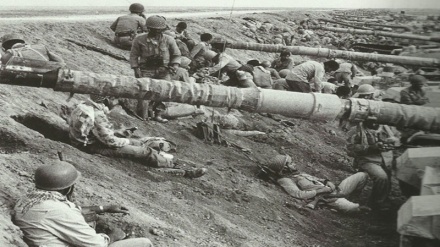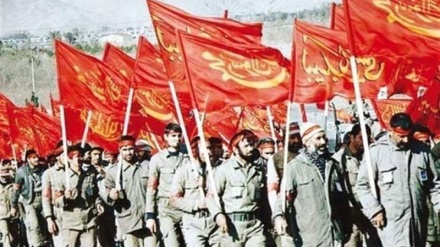Glimpses of Epic of the 8-Year Holy Defense (86)
Dear listeners, the main goal of the Iraqi dictator, Saddam, of initiating the 8-year war and invading Iran was to overthrow the Islamic Republic system.
Disintegration of Iran was his secondary goal. Saddam said in a speech in the beginning of his invasion of Iran, “We won’t be upset at disintegration and annihilation of Iran and we announce that if the country is adverse, every Iraqi person or maybe every Arab will intend to disintegrate and destroy Iran.”
The Iraqi Foreign Minister at that time, Tariq Aziz, also said, “A few smaller Irans will be better than a single Iran and we support rebels of different Iranian ethnicities, and will make every effort for disintegration.”
Anthony H. Cordesman, Western pundit, said, “It appears that Iraq has not really analyzed the effects of attacking a country that was in the middle of the revolution’s course. It seems that Iraq had simply assumed that its attack will lead to Iran’s disintegration rather than solidarity and unity. Even some of the Iraqi leaders, in their interviews, had admitted that they had never thought that their attack would have such an effect to cause uprising of masses in support of Ayatollah Khomeini.”
Wafiq al-Samarrai, the head of Iran’s section at the Iraqi security service, said, “At 12 o’clock of September, 22, 1980, 192 jetfighters of the Iraqi air force flew towards their goals inside the Iranian soil.” At that moment, the commander-in-chief, Saddam Hussein, entered the operation room with a red keffiyeh on his head and a cartridge around his waist. Then, Iraqi Defence Minister, Adnan Kheirullah, told him, “My master! The youths flew 20 minutes ago.” Saddam said, “We will break Iran’s back within half an hour.” These hollow remarks and this much of ranting were thwarted thanks to the selfless combatants who under the unmatched leadership of Imam Khomeini brought the Iraqi dictator and his Western and Eastern bloodthirsty supporters and partners-in-crime to their knees. American expert, Alan Friedman, quoting the White House officials, said, “Our forces would grant a lot of tactical helps to the Iraqi military at the war front. Sometimes, they would even go to the Iranian border alongside Iraqi soldiers. And this continued till 1987.”
Howard Teicher, a senior expert of the US National Security Council, said that what the US did for Saddam it had not done to any of the close allies. Kenneth Timmerman writes in his book that Saddam in June 1982 signed a contract with a Belgian company worth $830 million. The aim of that costly project was to build bunker for 800 Iraqi advanced fighters at the depth of 50 meters underground. The project was dubbed as Project 505. The Belgian company benefited from the Belgian government’s credits. During 4 years, it constructed 17 air bases and several military bases in Iraq. The French mirage aircrafts would fly from the same bases to attack Iran.
The Belgian consortium built the largest factories for chemical examinations and production of phosphate in the world. Timmerman continues that the United States, before sending its envoy to Baghdad, had deployed a full-time head at the American intelligence station in the capital. He had a high status with Saddam and would be consulted before every great attack. Alan Friedman writes that delivery of weapons continued almost on a daily basis. One of the NATO bases was located in Central France. It was the place of loading Antonov bombers of the Iraqi air force to carry cluster bombs and radar equipment to Iraq. As we had said earlier, French intelligence services had estimated that if they had cut helps to Iraq for three weeks, the Iraqi army would have failed. The chemical weapons and assistance that the Western regimes granted to Saddam claimed over 100 thousand martyrs and injured among the Iranian armed forces and civilians. Some of the chemical weapons included phosphate compounds and mustard. It was the second time after WWI that such weapons were used widely in war. This measure of the Iraqi regime was in utter violation of the 1925 Geneva Protocol. Iraq used these lethal weapons both in the fronts and over the Iranian cities. The city of Sardasht with nearly 12 thousand people was one of these civil areas that was bombarded by the Iraqi bombers on June 28, 1987. Saddam’s criminal army dropped bombs of mustard gas over the city causing a gruesome disaster. Today there are still over 50,000 Iranians who are suffering from the effects of chemical bombs and missiles of Saddam.
The most horrendous chemical crime of Saddam’s air force was the bombardment of the Iraqi city of Halabja in February 1987 because the people of the city had accorded warm welcome to the Iranian forces. In that heinous crime more than 5,000 Iraqi Kurds were massacred in cold blood. Some 7,000 others also sustained serious injuries. The gory crime has been compared with the atomic bombardment of the Japanese cities of Hiroshima and Nagasaki after the end of WWII. The UN Secretary General in the years of Iraqi war against Iran, Javier Perez de Cuellar, in response to whether Iran’s defence of legitimate or not, said, “There is no doubt in it. This was the best thing that a nation could do against aggression to its nation. It is different to have a fight between two armies than an army and a popular resistance. Iran’s resistance against Iraq was a popular resistance. That’s why it caused Iran to triumph. You triumphed because you succeeded to resist against the aggressor and pushed him back.
RM/SS


